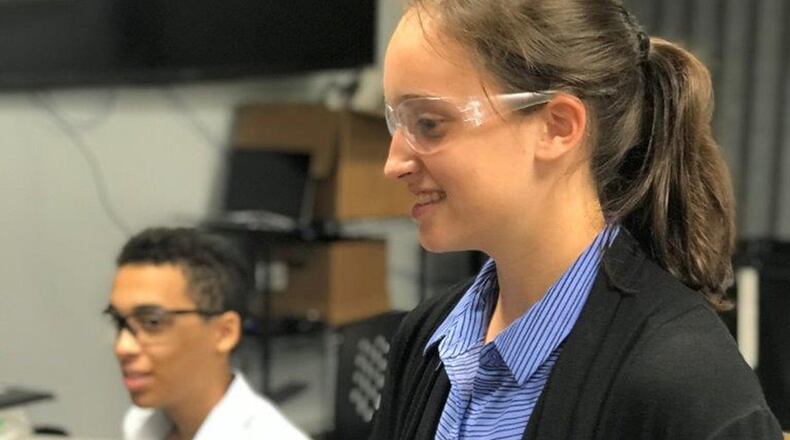“Everyone always talks about the pipeline. We’re trying to get kids involved in DoD STEM, but where is our pipeline? LEGACY was our answer,” said Dann Andrews, Education Outreach Office director. “It is an Air Force program, and we piloted it here at Wright-Patterson. It covers sixth grade through college. This is not just scientists and engineers – we’re going after a technical workforce, we’re going after the finance folks. It’s not just the ‘S’s and E’s’; it’s all of STEM.”
As a grass-roots program, LEGACY proved a success in its first year at Wright-Patterson Air Force Base, receiving recognition from the National Defense Education Program, which funded the expansion of LEGACY to include Robins Air Force Base, Eglin Air Force Base and the United States Air Force Academy.
“The Air Force is really investing in the future work force and in young, diverse talent,” said Dr. Amanda Bullock, LEGACY program manager. “We recruit students who are under-represented in STEM, students of a minority gender or race, first-generation college students and students from urban and rural communities. By recruiting and retaining young talent from the local areas, we are home-growing our talent. If they start in sixth grade, we get to see them for six years before they go to college.”
LEGACY students start in summer camps, where they are called craftsmen. These camps are offered for sixth through 10th grade. Once students turn 16, they may be hired as junior apprentices and are given job placements as contractors in various labs at their local base. They are expected to work 320 hours over 10 weeks and also take part in a cohort project.
After graduating high school, students may return as apprentices, the primary difference being they are given a solo or small group project related to their field of work.
The goal is to then transition the LEGACY apprenticeships into Air Force-wide internships.
“The Air Force never had a STEM camp to feed into all of the college internships they have across the base,” said Bullock. “Now, we can recommend our LEGACY students to PATHWAYS and complete the pipeline.”
LEGACY is putting students in labs, in real-world settings.
“We have students in the hospital, we have students in AFRL [Air Force Research Laboratory], we have students in the STRONG lab at the 711th Human Performance Wing, we even have a student at AFIT [Air Force Institute of Technology] this year,” said Bullock. “They are doing everything from biomedical engineering and devices to structural and material testing – such a wide variety. These students are working on anything you could think of – as long as it’s not classified.”
Michelle Wong, a LEGACY junior apprentice and senior at Wayne High School, said her favorite part of the program is the hands-on experience.
“Just being in the LEGACY program I get to do hands-on, real-world work. The data I’m collecting is actually being used; it’s not just textbook material. There is no checking the book to see if the answer is right, we don’t know until we test it. I get this real-world experience that a lot of my peers won’t get to have,” said Wong.
Scott Tursic, another LEGACY junior apprentice and a senior at Shawnee High School, agreed.
“My mentor has been really gracious and let me do a lot of the experimenting. He supervises, of course, to make sure nothing terrible happens. We are going to be publishing a paper about some of our molecule comparisons,” said Tursic. “It feels pretty cool having the opportunity to be published possibly before I graduate high school. It’s an incredible opportunity.”
The LEGACY program is more than just lab time for these students, however.
“LEGACY has helped me figure out what I want to do with my life,” said Jayln Clayton, a LEGACY apprentice and freshman at Sinclair Community College. “I job shadowed through the LEGACY program. That’s how I found out I wanted to be a dietitian. I shadowed a diet tech for a day and I loved it. I knew immediately it was what I wanted to do.”
Clayton isn’t the only student who found their way through LEGACY.
“We also do ‘partner-swaps’ every Friday,” said Tursic. “It was really helpful when I was between psychology and engineering, because there was another LEGACY student that was working in the 711th Human Performance Wing with a psychology aspect, so I was able to go over there every other Friday, and it helped me narrow down my career interest to mechanical engineering.”
Beyond helping students narrow down the aspect of STEM that interests them most, LEGACY also helps them to maximize their potential.
“On Thursdays we do lunch-and-learns, which is more than just STEM. We talk about college applications, tax forms, etiquette and things of that nature,” said Tursic.
LEGACY also helps students access opportunities.
“LEGACY told me about a two-week camp at MIT and helped me apply,” said Wong. “They supported me through the whole process.”
Wong hopes to bring her interest in engineering back to the Air Force after college.
“It’s been fantastic working with the Air Force, and I’ve loved every second of it,” said Wong.
Tursic agrees, remarking on his favorite aspects of working with the Air Force: “The atmosphere in the labs here is very collaborative. We’re working together and it’s great that we get to help our country.”
About the Author
